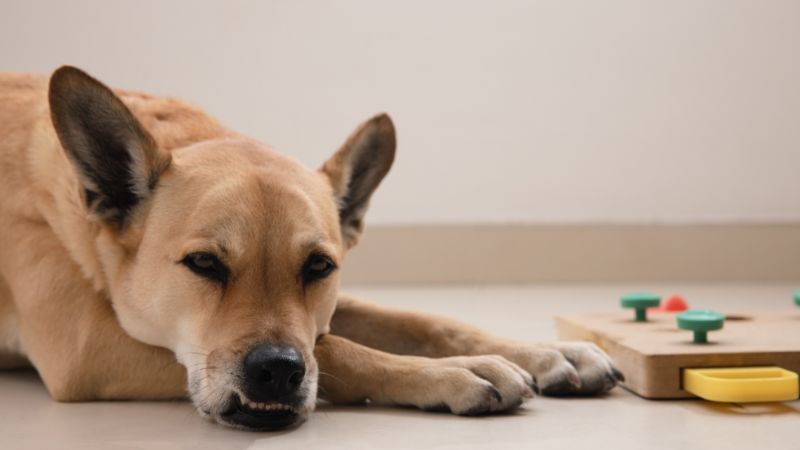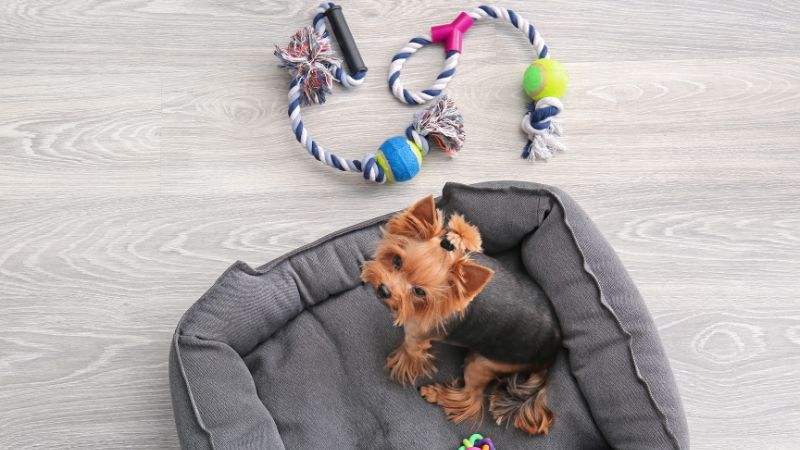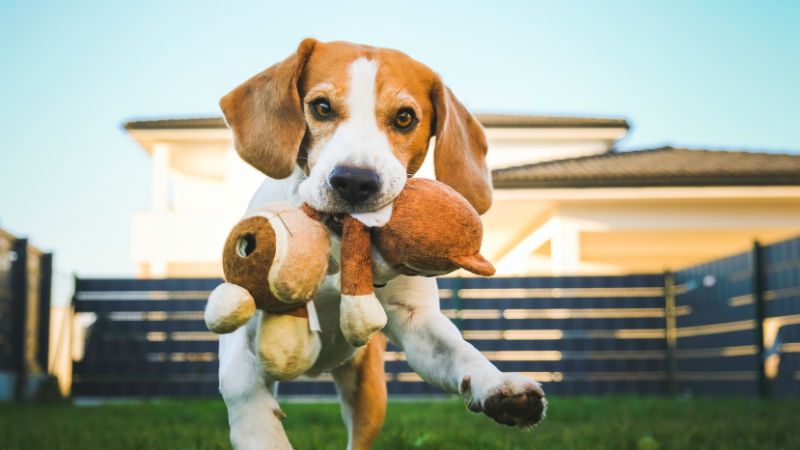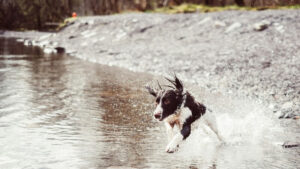
How To Create A DIY Dog Toy For Chasing with Noise Effects
Incorporating a dog toy for chasing into your pet’s play routine is a fantastic way to keep them engaged and active. The allure of a

We are exploring the many benefits of playtime for dogs. Just like us, dogs should participate in activities that challenge their minds and bodies.
Brain games for dogs are an excellent way to achieve this!
We understand that ensuring dogs get enough physical exercise is crucial for their well-being, but we often overlook the significance of mental stimulation.
Dogs are naturally inquisitive and intelligent creatures, capable of more than we often realize.
That’s why dog owners should invest time in engaging their furry companions with games that promote mental skills like concentration, memory, and problem-solving.
By involving your dog in brain games, you can enhance their mood, behavior, and sleep patterns. Mental stimulation for dogs can tire your dog out, leading to a peaceful night’s rest.
Think about how exhausted you can feel after a demanding workweek, or how children become sleepy after a day of learning at school.
It’s quite similar for our beloved four-legged friends!

Extensive research worldwide has delved into the canine brain, revealing surprising findings.
Dogs exhibit remarkable intuition—they can interpret human facial expressions and even possess the potential to grasp counting skills and understand concepts like object permanence.
When dogs become bored, they attempt to create their amusement, often engaging in behaviors considered unacceptable by their human caregivers.
While your dog is merely trying to keep itself entertained, such actions can be seen as problematic or even destructive to us.
Hence, it becomes vital to keep your dog’s brain active and occupied throughout the day.
Ensuring your dog receives mental stimulation can be as simple as offering ample opportunities for sniffing and exploration during walks.
If you wish to take it a step further, you can engage in various brain games designed for dogs.
If you’re wondering how to engage your dog’s mind, you’re in for a treat—there are countless options!
Most of these stimulating intellectual games for dogs can be seamlessly integrated into your furry friend’s daily schedule, enhancing their focus and promoting desirable behavior.
Enhance your dog’s problem-solving abilities with engaging brain training for your dog like hide and find.
This activity also provides a chance to reinforce essential dog commands like ‘wait’ and ‘come,’ as well as introduce new ones like ‘find.’
You can explore various versions of this game, challenging your dog to search for treats, toys, or even you!
Teaching your dog new tricks is an excellent way to provide them with mental exercise. It requires their full concentration, making it a rewarding brain workout!
When you use positive, reward-based training methods, you not only teach your dog new skills but also boost their confidence and overall happiness.
Don’t forget to shower them with praise and enthusiasm to make the learning process even more enjoyable.
While we’ve all heard of tricks like ‘paw’ and ‘shake hands,’ there’s a vast array of other tricks you can add to your dog’s skill set.
These fun tricks not only entertain but also provide great mental stimulation:
Designing obstacle courses offers numerous advantages for your dog. These courses not only stimulate their mind but also enhance agility and physical fitness.
You can easily create a thrilling obstacle course using everyday household items such as chairs, bed sheets, mops, or brooms, either indoors or in your garden. Alternatively, you can enroll your dog in agility training classes in your local area. In both cases, your dog will relish the opportunity to expend pent-up energy while navigating through a range of obstacles.
These courses provide mental stimulation as your dog strategizes how to overcome each obstacle, promoting problem-solving skills. Moreover, they help improve your dog’s physical prowess, encouraging them to stay active and healthy.
Whether you opt for DIY obstacle courses or professional training, your dog is sure to adore the challenge and the chance to embark on an exhilarating mental and physical adventure.

This game is excellent for getting your dog to focus on you. You’ll need three cups and a treat, like a piece of yummy snack.
Before you begin the dog brain game, ensure that each cup smells like a treat. You can easily do this by rubbing the treat around the inside rim of each cup. Next, with your dog observing, hide the treat beneath one of the turned-over cups and place the other two cups next to it.
While your dog keeps an eye on you, mix up the cups, and then let them use their paw or nose to attempt to flip over the correct cup. If they pick the wrong one, show them the treat, but don’t let them have it. Shuffle the cups again, and let them try until they can track down the right cup!
There are many ways that dog toys can be used to train your dog’s mind. Toys come in all shapes and sizes, with different features to make playtime fun and interesting.
Try this retractable dog chase toy, the retractable feature adds an element of surprise and unpredictability, making each play session a thrilling adventure. As your dog chases after the toy, their problem-solving skills come into play as they strategize and anticipate its movements.
Start by picking a toy for this game. It should be one your dog loves and can easily recognize. For hiding spots, begin with simple ones like under a blanket or behind a cushion where the toy is still a bit visible.
Show the toy to your dog and let them sniff it to get them interested. While they’re focused, go to one of the hiding spots and place the toy there. Use cue words like “Search!” or “Find the toy!” to encourage them to find it.
When your dog finds the toy, it’s time for rewards and celebrations. Give them lots of praise, treats, and affection. You can even play a quick game of tug-of-war with the toy as a special treat.
As your dog gets better at the game, you can make it more challenging. Hide the toy in trickier spots like behind doors, on higher surfaces, or even in your backyard if you have one.
Don’t forget to let your dog know when the game is over by giving them a signal like “finish” or “it’s over” so they can relax.

If your dog already knows the ‘drop it’ or ‘give it’ command, you can take it a step further by teaching them to put their toys back in the toy box, basket, or container when playtime ends.
This game taps into a dog’s natural instinct to fetch and retrieve. It not only helps signal the end of playtime and wind down but also promotes independence. Plus, it means one less task for you to worry about when it’s cleanup time!
This brain game puts your dog’s thinking skills to the test! Hide pieces of your dog’s favorite treat around the house or garden and let them embark on a delicious treasure hunt. Your dog will rely on their nose to track down the tasty rewards.
To keep things exciting, make each round of this dog brain game more challenging. If your dog has a knack for following scents, create a ‘trail’ for them to follow. Simply take a mouthwatering treat, touch it on various surfaces around the house or garden in a continuous path, and hide it at the end.
While dogs enjoy tracking scents, it’s a good idea to introduce a start signal (like “search”) and an end signal (like “finish”) for the game. This way, your dog will understand when it’s time to search and when it’s time to relax once the game concludes.
If you found this article useful, you might also be interested in – 5 Stimulating Dog Toys For Your Dog’s Mental Exercise
After we know how to mentally stimulate your dog. Next, ensuring your furry companion gets the right amount of mental stimulation is essential for their well-being. As a minimum guideline, aim for 30 minutes of playtime for your dog each day, ideally divided into two 15-minute sessions. However, it’s crucial to recognize that the specific mental stimulation needs of dogs can vary significantly, so keen observation is key.
Understanding your dog’s unique requirements is essential. Larger breeds with high energy levels generally demand more mental stimulation than their smaller counterparts. Factors like age, breed, and individual temperament also play a role in determining the ideal amount of mental exercise.
To maintain a happy and healthy canine companion, pay attention to their cues, adapt their playtime accordingly, and keep them engaged with brain games and activities tailored to their specific needs. This approach ensures that your dog receives the right balance of mental stimulation to keep their mind sharp and their spirits high.


Incorporating a dog toy for chasing into your pet’s play routine is a fantastic way to keep them engaged and active. The allure of a

The joy of play is unparalleled for dogs, especially when it involves a dog toy for chasing. Imagine enhancing this experience by adding a personalized

Imagine a dog toy for chasing . That’s not just any toy, but one tailored specifically for the gentle jaws and slower paces of senior

There’s something incredibly satisfying about crafting a dog toy for chasing. It’s not just about saving money or being eco-friendly; it’s about personalizing playtime and

Incorporating a dog toy for chasing into your pet’s play routine is a fantastic way to keep them engaged and active. The allure of a

The joy of play is unparalleled for dogs, especially when it involves a dog toy for chasing. Imagine enhancing this experience by adding a personalized

Imagine a dog toy for chasing . That’s not just any toy, but one tailored specifically for the gentle jaws and slower paces of senior

There’s something incredibly satisfying about crafting a dog toy for chasing. It’s not just about saving money or being eco-friendly; it’s about personalizing playtime and
Copyright © 2024 dogchasetoy. All Rights Reserved.